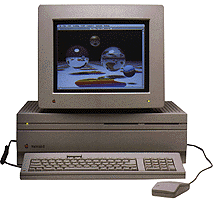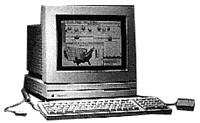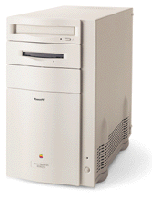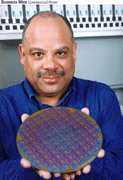
| The PowerPC Triumph |
Credits: Insanely Great: The Life and Times of Macintosh, Upgrading and Repairing Your Mac, The Mac Bathroom Reader
There are sections in this site where I describe the period in Apple's life where they sold super-fast and super-expensive machines such as the Mac II and Quadra series. This was around the late 80s and early 90s, a time where Apple's stock was at an all time high, just like the criticism. Several people criticized the high price tags of the models Apple was developing, to which a former Apple VP replied "We make Hondas, not Yugos". Though the quote became popular among Mac enthusiasts, projects at Apple also started creating more reasonably priced computers that were still very innovative, like the Mac LC. Even so, it became clear that Apple was traveling down a crowded path and again needed to create a new breakthrough technology to secure its position as a leader in innovative products. Like the Apple II and Macintosh projects before it, it would be one man's vision that would make this happen for Apple. Jack McHenry was a veteran Apple engineer who worked on such influential products like the first Mac hard drive, and was the father of Apple's the Mac IIfx, Apple's most powerful machine at the time.
 |
This was a fact not lost by Apple, already seeking a way to create even faster Macs. The "Jaguar" project was created to develop a new type of RISC-based machine that would use this technology to boost Apple ahead of its competition. The only problem the project saw was compatiblity. The one problem with switching to any kind of processor is that all software written for that platform suddenly becomes obsolete. You can't run software for a processor that it is not designed for. This meant that the new RISC-based Apple machine would be totally incompatible with current Mac software. Like the Lisa before it, the machine would be useless without anything to run on it. Of course, several programmers gladly lent their expertise to the project. They were all awed by the power of RISC computing, and the things it would be capable of bringing to the market. By 1990, only a year after the introduction of the Mac IIfx, there were two to three dozen engineers working on projects for Jaguar.
Enter again Jack McHenry. He didn't see the Jaguar project as the answer to Apple's needs. Backward compatibility was a must for a project that would succeed the 68k Mac. How can 6 years of software development to a company whose software base is already miniscule be scrapped? It is why on a March, 1990 ski trip to Reno, McHenry and a group of fellow engineers decided they would embark on a project that would implement RISC technology but still retain 68k compatibility. The project was later name "Cognac", after a pioneering engineer of the RISC processor named Jack Hennessy who had a surname similar to the liqueur. The group included colleagues that worked on the IIfx project, liked Bob Hollyer and Jon Finch. Again similar to the Mac/Lisa development, there was much competition between the two projects. Cognac beleived Jaguar was doomed to failure, for their philosophyt was flawed. Though some applications would inevitably run on the Jaguar machine, incompatibility with 68k software made the large amount of smaller commercial, shareware, and freeware programs unusable to the new system. Surely enough, and luckily for Apple, the Jaguar project would never release a machine.
In the meantime, the Cognac team had to figure out a way to incorporate 68k compatibility in their machine. They had two logical options, each with their pros and cons. Unfortunately, both of them were mostly cons. One choice was two include two processors on the motherboard. The dual-processor idea would guarantee that software written for both chips were run with optimum speed . The problem with it was that dual-processor machines had never been successful in the market up to this point. Consumers were not willing to pay that much money for a computer, despite its features. It was a novel idea, but Apple could not justify yet another costly beast to roll of their production line. The second option was emulation. You can emulate hardware, in which you use the processor to trick the machine into thinking it is running hardware that it is not. They could use the super-charged RISC chip to run 68k instruction sets using a built-in emulator. The problem with this method is the fact that you greatly sacrifice speed. If you have ever used an emulator that mimics another processor (like SoftWindows, or VirtualPC) then you know that emulation of this sort can be a headache. It seemed this would be another dead end. At least until later that year. This is when the team figured out a way to create a much faster emulator exploiting what is called the 90/10 rule. The 90/10 rule is just a principle that states that when you write a large computer program, like a word processor, you will be running only 10% of the software's code 90% of the time. Using this principle, the Cognac team could create an emulator that would exploit this principle to create a much faster emulator. All they needed now was a RISC processor and a machine to put it in, and they could start working on their theory.
The man that would make this happen was Gary Davidian, an expert in the field in programming microprocessors and ROMs. He wrote the 68k emulator for every RISC chip Cognac was using currently, which changed often. When Cognac used a new chip, Gary wrote a new amulator. It was an unimaginable feat making not just one but several processors mimic the instruction set of the 68k processor family. Both RISC projects worked on their projects to reach the first major step in developing their new machine, point is called "gray screen". Thi is when for the first time an image appears on the monitor of the machine, usually a checkerboard pattern of white an black pixels, hence the name. Cognac worked at a smooth pace, and in late 1990 they achieved gray screen status. Finally, in 1991 Apple decided on a RISC chip. Despite consistent deadline problems Apple and Motorola had maintained a good working relationship until now, as Apple had used Motorola processors to power their machines for roughly a decade. So it was no surprise that Apple decided to use Motorola's RISC chip. An excellent proposition to Motorola it seemed since even though the company would use their RISC chips in their radios, pagers, and so on, recruitment by Apple would increase their business beyond their wildest dreams. Gary rewrote his emulator using the tricks he had learned along the way. Meanwhile, the Jaguar team changed their codename to "Tesseract", but had no new progress to show off with their new name.
 |
If you ask an avid Mac user about the origins of the PowerPC, they will usually start with what happens next. At the same time Cognac was working on the RLC, Apple had been collaborating on another revolutionary project. On April 12, 1991 Jack Sculley, then CEO of Apple, gave a surprising demonstration. IBM engineers presented an IBM PS/2 Model 70 running a prototype OS that looked remarkably like the newly released System 7. Now you must remember that at this time IBM was still the archnemesis, the "dark side" to Mac users. With this in mind imagine the site of an IBM computer running an Intel-savvy version of the Mac OS running faster on a 486 than a 68040. This was a sign of things to come. The OS that was running on the PS/2 was a protype of "Pink", an object-oriented version of the Mac OS that would run much faster and more efficient than System 7. IBM was interested in Apple's RISC project and on July 3 sent a letter of intent saying that it would help create Pink if it will use their yet-to-be-developed RISC chip. After some negotiations, Apple announced to a shocked computer industry of their future plans on October 2.
It was called the Deal of the Century. Among the many agreements, Apple and IBM will create RISC-based machines and produce two companies, Taligent and Kaleida. The latter company would work on Pink, which would run on the RISC processor, dubbed the PowerPC. Motorola would be work in conjunction with the PowerPC project and its distribution. Kaleida would develop multimedia tools. The main deal here was the PowerPC, as it was planned to be the centerpiece of both Mac and IBM computers. This was highly unusual, and many thought it was a vain attempt that would surely fail. "Whoever thinks PowerPC will work is smoking dope" commented one journalist. Frankly, you couldn't blame them. Two formerly rival companies that are exact opposites designing a new operating system for a processor that they will both use but that doesn't exist? It seemed downright ridiculous to Mac and IBM users alike. But that was politics to Apple and IBM engineers, who were more concerned with how they were going to work together to make this happen. Cognac now had to rewrite their emulator to conform to a vaporous processor. Moreover, they now have to collaborate with IBM, who had totally different development methods. The complexity of the project had increased one hundred fold. Execution would have to be near perfect if they wanted this to work.
Fortunately, near perfect it was. It was apparent that everybody wanted this to work. IBM officials often tried to accomodate Apple and vice versa so that both could comfortably work in unison. One popular anecdote talks of one of the first meetings between the two computer giants. IBM engineers dressed in blue jeans for the meeting, while Apple engineers dressed in suits. They both tried to make each other feel compfortable by conforming to what they thought the other was like. After that the Austin, Texas PowerPC design center, called Somerset, was a lot more relaxed. It was now the end of 1991, and by that November Apple and IBM had finished the details in the transaction. The first PowerPC processors were to be designed at Somerset and would arrive at Apple in one year and Apple would introduce the PowerPC-based Power PowerMacintosh series on the Mac's 10th anniversary, January 24, 1994. Skepticism was high after this announcement. Computer users know that deadlines in the computer industry are more like unlikely targets, and this was even more so with the chip industry. As I said before Morotola had several problems with making deadlines, with two other companies working together simultaneously, depending on each other to make everything work made it seem like an impossible target.
 |
Another thing that makes the PowerPC cool is that it supports Superscalar processing. What the hell does that mean? Well, it can perform tasks using the three units described above simultaneously per cycle. It can do all three things at once. This is the reason why even though some PowerPC processors have a slower clock speed, it can actually run faster than those with a higher clock speed. The last ingenius feature of the PowerPC is how small, cheap, and energy efficient it is. PPCs are half the size of Pentiums, cost half as much, and use much, much less power.
 |
 |
 |
This is where the PowerMac project ran into problems. PDM, Cold Fusion, and Carl Sagan all ran versions of the Mac OS and Mac software just fine. The problem was that it didn't run much in native code. The immense power of the PowerPC was being wasted on 68k instruction sets instead of blazing through native PowerPC instructions. It was in part due to prejudice towards either IBM or the PowerPC project all together. Mac heads didn't want to work on a new System that would eventually do away with the 68k. It turned out that a new System wasn't going to happen. Pink was way behind schedule, and would soon be cancelled. Taligent would soon close. Apple engineers found that Power Macintoshes should run the exact same thing as normal Macintoshes anyway. So that's what they did. System 7 was rewritten with some native code, but essentially was exactly the same as 68k versions of System 7. Even today Mac OS 8 still had some 68k code and is not completely "native", though the Finder and many components are. It won't be until the 1999 release of Sonata that the true power of the PPC is used. Anyway, engineers finally released the PowerMacs, now called the 6100/60 (PDM), 7100/66 (Cold Fusion), and 8100/80 (Carl Sagan, BHA, LAW). In March 14, 1994, right on schedule, the models were introduced at the Lincoln Center in New York City.
 |